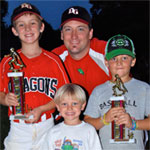Catcher Position Clinic
1. Receiving the ball/stance/no runner on
Balance in your stance is key. Make sure your head is over your feet and your glove side elbow is on top of your knee, with the glove up (fingers pointing to the sky) for a good target for your pitcher. Your weight should be on the inside portion of your feet, your throwing hand behind you. In this position is is okay to be settled down in your stance with your butt on your feet.
2. Stance with a runner on or two strikes
With two strikes you have to guard against a passed ball or ball in the dirt that the hitter will swing at and miss for strike three that you will need to block. With a runner on, you have to guard against the steal. In both situations, you have to be in a more athletic position so you are able to move quicker. Your glove position, throwing hand position and weight distribution are the same, but your butt now needs to be off your heels with your thighs parallel to the ground and your stance needs to widen to enable you to move quicker.
3. How to give signs
With your glove outside of your knee and toes pointing straight ahead, give sign against your cup.
4. Blocking balls
The idea behind blocking is balls is just that, blocking. You are not trying to catch the ball, merely stop it from getting by you. Body position is very important here. Your first reaction is to move your feet to get in front of the ball. If you can do that, drop to your knees and place your glove between your knees to block the gap with top of glove on the ground. Your upper body will be tilted forward slightly and your shoulders will pinch in. Head on pitch coming in, throwing hand open, palm to the pitcher.
5. Throwing to second
From your athletic stance, let the ball get you. This is important. Some kids will want to jump out and get it. Remember, there is still a hitter there who may swing the bat. Receive the ball and you now become a fielder making a throw. As you come up out of your stance, you will take a small step toward your target to gain some momentum, get sideways to your target in your strong throwing position, and throw.
6. Throwing to third
Throwing to third requires a bit more athleticism because you have to avoid the hitter. Same athletic stance as throwing to second, but remember, the hitter has a right to the box and does not have to move or duck. You can either step out in front of the hitter or step behind the hitter. Sometimes the pitch may dictate which is the best course of action. For instance, an outside pitch may be easier to step out in front of the hitter. An inside pitch may be easier to go behind the hitter. It may take an extra step to get your body in position as well. Taking the extra step will allow you to get more on the throw, keep you more balanced and help you to be more accurate.
7. Catching pop-ups
For the younger players, catching pop-ups is not much different than any infielder catching pop-ups. Take your mask off and locate the ball, then throw the mask out of the way so you don’t trip on it. For the older players where the balls will be hit higher, the catcher wants to turn his body so his back is facing the infield. We do this because of the rotation of the ball. High pop-ups right on home plate will be rotating so the ball will be coming back towards the infield. With the catcher’s back turned toward the infield, the pop-up will now be coming in to him, not going away from him. Same rules apply with the mask. Take off the mask first, find the ball, then discard the mask away from the play.
8. Plays at the plate
My recommendation is to all leave your mask on. This protects you from the runner in case of incidental contact or bad hops on the throw from the fielder. As with any base, you cannot block the plate without the ball. When awaiting the throw, have your left foot right on the left front corner of home plate facing third base. This puts your knee in a stronger position and will help guard against the runner sliding into you from the side and collapsing your knee inward. Catch the ball, move in front of home plate with both hands on the ball and tag the runner.
9. Dropped third strikes
The biggest concern here is locating the ball. Find the ball first and then, if you have to, create a good angle to throw to the first baseman. This means taking a step either left or right to get the path of your throw away from the runner.
10. How to think as a catcher
You can control the tempo of the game. You are also involved on every play, so you have to be alert all the time. Really need to work on catching/blocking skills.
Drills
- Basic catching drills
- Throwing to second base-footwork
- Blocking balls in the dirt
Fun advanced drills
- Retrieving passed ball at the fence and throwing to pitcher covering home
- Discarding mask properly and catching pop-ups
- Fielding bunts and throwing to first

